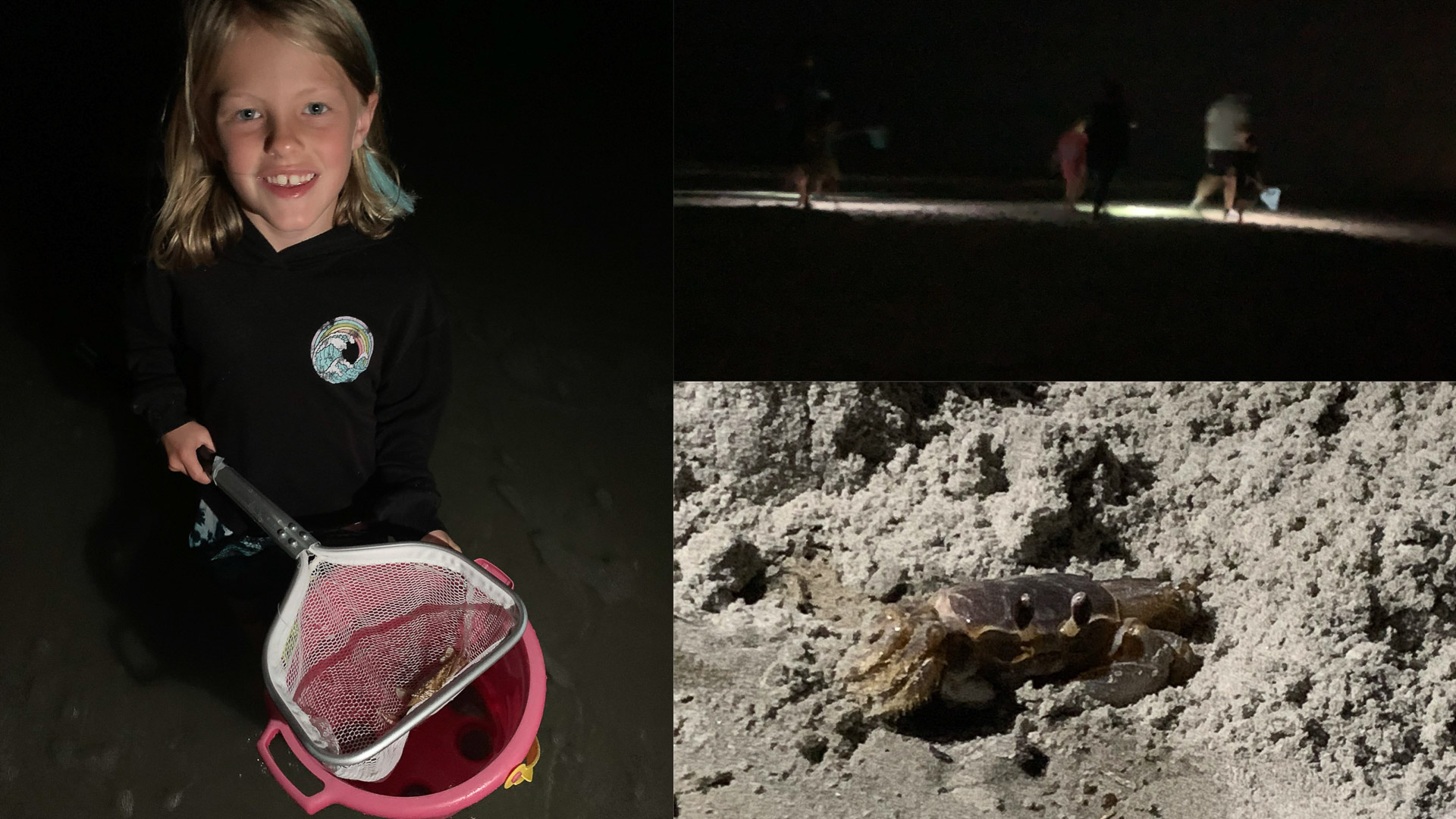
Called the “raiders of the night,” ghost and speckled swimming crabs are straw- or grayish-colored crabs and are terrestrial. Speckled swimming crabs also have white spots across their shells. Both crabs can be found on the shores of the ocean from Massachusetts to Brazil. These crabs burrow during the daytime in sandy beaches, coming out mostly at night to find food or a mate or to wet their gills if they can’t extract enough water from the tunnels they build in the sand. A traditional summer activity on the Carolina shores is for beachgoers of all ages to head to the beach and go crab hunting.

Head Out At The Right Time
The months of May through September are prime for crab hunting. Very skittish and on alert, ghost and speckled crabs come out at night when the beaches are empty for the day and the sun has set. Nighttime is feeding time for these crustaceans, so they emerge from their burrows looking for coquina, insects and clams. Both crabs mate year-round, with spawning occurring between April and August. Female crabs can be seen heading into the water under the safety of night to release their eggs into the surf.

Pick A Quiet And Secluded Beach
With eyes that rotate 360 degrees, both these types of crabs are always on alert. They can easily detect motion and noise. Choose an area of the beach that isn’t crowded with other crab hunters and is free from loud noise. When hunting, try to use hand motions rather than words or keep conversations quiet and short.

Grab Your Simple Gear
One of the best things about going ghost crab hunting is you need relatively little gear. Honestly, a flashlight is all you need. Even the flashlight on your phone will work! If you want to get more into this activity, consider bringing a net and a bucket. This way, you can catch a crab and spend some time observing it before you let it go. With that said, crabs are good climbers. For this reason, bring a large and deep bucket, as they will most likely be able to escape from a typical child-size sand bucket. Kids may enjoy using a headlamp instead of a flashlight, too, in case they want to try to hold one.

Wear Dark Clothing
Both these types of crabs are known for having swift feet. With this in mind, they are always on high alert for predators, including gulls. By wearing dark clothing, you will blend in and not call attention to yourself as a predator. This will help keep the crabs from darting away from you at speeds up to 10 mph.

Look High And Low
When we go crabbing, we tend to have the best luck catching crabs in water around shin-deep. These crabs tend to be younger crabs ranging in size, or sometimes even mama crabs ready to release their egg sacs. Larger and older crabs tend to burrow near the marshland at the end of the beach. For this reason, scan the beach looking for any movement near the water, in the water and near the marsh. If you don’t find any in one spot, head to another. It sometimes takes some patience to find your first crab or two.

Have A Team To Help You Catch One
The easiest way to catch a crab is in teams of two to three people. One person can be in charge of shining the light and helping spot the crab. The other one can then concentrate on catching the crab with the net. If you have a spare person, you can also have them be a spotter. Shine a light into the surf to spot a crab. Once you have spotted one, use your net to catch the crab as it rides with the tides. For us, we have the most luck spotting a crab in between the waves and catching them as the water recedes back into the ocean. If you are catching crabs on the beach versus in the surf, toss a bit of sand onto the crab while it is frozen in the light. This will actually help calm the crab so it doesn’t run off. From behind, use a net to scoop the crab up. If you are trying to catch the crab with your bare hands, approach it again from behind. Press your finger gently onto the back of the crab’s shell. Pick the crab up carefully, and then place it into a net or larger bucket.

Letting Your Crab Go
Even if your crab catchers want to keep the crabs as pets, you will need to let the crabs go back to the safety of the ocean and beach at some point. If you caught crabs in the surf, bring them back to the surf. Giving space around you, simply place the bucket in the water and tip it gently to allow the crab(s) to crawl out and head back into the water. If you catch the crab(s) on the sand, follow the same steps and let them go back onto the sand. If your crab is still in a net, it may take a bit more work to get them to release the net with their pincers. Just be mindful of your fingers, and try to have the net close to the ground to minimize the drop the crab will take when it lets go.





